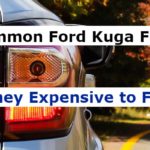Sedan vs. SUV Safety. What’s Safer? (+Crash Tests)
Every household currently owns an SUV or is making plans to purchase one. These vehicles are a popular choice in homes where they need one vehicle to be able to do everything.
Where sedans, wagons, and minivans used to be the answer to a one-car garage, SUVs now seem to be the only choice. We see them at schools, offices, and even law enforcement.
People tend to think the extra ground clearance of these vehicles makes them safer. Some even say the higher seating position helps them see ahead better. But with many more of them on the road, are they safer than sedans?
Are Sedans Safer than SUVs?
Not really, sedans are safe, but SUVs seem to have an edge over them. The bigger, larger, and heavier body structure seems to give SUVs added safety. This doesn’t apply to all SUVs, though, as some sedans are still just as safe as any SUV.
SUVs are heavier, but this is a result of more metal being used in making them. These extra metal parts add to the crash structure of the vehicle absorbing more impact in case of a collision or crash.
Studies have shown that 50% of passengers were likely to survive an accident than those in sedans. 8% were more likely to be killed in a sedan than an SUV. Even with head-on collisions, an SUV driver is 7.6 times more likely to survive than a sedan driver.
Also read: Are Small Cars Dangerous? Why SUVs aren’t Safe?
What Makes SUVs Safer than Sedans?
The sheer size and weight of SUVs are a huge factor as to why they are safer. An accident involving an SUV and sedan will most times see the sedan receive more damage than the SUV.
You can watch an SUV crash tested here.
SUVs have a larger total surface area to dispense energy caused by impact. These could be head-on, side impacts, sideswipes, T bone, etc. The larger size and body coupled with the safety equipment help protect passengers more effectively.
With its size, you’re also less likely to be found under anything. Sedans do tend to run under bigger trucks or trailers in accident cases. But with SUVs, having a raised hood ensures your vehicle won’t go under things easily.
Also, the reinforced body and frame allow the addition of extra protective accessories like a push bar in front of the vehicle.
Why are Some SUVs not Perfect When it Comes to Safety?
SUVs with their raised ride height also raise their center of gravity. This increases the risk of a rollover from side-impact and during certain swift maneuvers. SUVs have a rollover rate of 12%, compared to sedans at just 3%.
SUVs generally score better than sedans in many of the safety tests. But the one place where they haven’t excelled at is rollovers. Rollovers are situations where a vehicle could flip on its side either during an accident or swift maneuver or even crawl past an angled slope/incline.
Because these vehicles are top-heavy, certain maneuvers like swerving quickly to dodge something could end up with your SUV on its side or roof. A fatal hit from the side at a decent speed could result in this unfortunate position.
Going slow on a steep slope or banked surface could also land your SUV on its side. With their extra ground clearance, SUVs can walk almost over any surface. But if the slope/gradient about to be driven on is miscalculated, once the SUV drives on it and the SUV tilts a little too much it will fall on its side. In a more severe case, the inertia will land it on its roof.
Trending Video: How to Easily Bring Back to Life any Old Car Battery and Save Tons of Money (click to watch)
Lastly, there are so many SUVs on the road today. Many of the advantages SUVs had against smaller vehicles are being negated. Now, accidents will involve SUVs that are equally raised and heavy.
Why are Sedans Still Relatively Safe?
New cars are getting safer and the gap between SUV and sedans are getting thinner. Combine this with the fact that sedans are harder to roll over, sedans and SUVs, and pretty close in terms of safety. Sedans are also lighter, so the brake assist, collision assist systems work effectively on a lighter car.
Here’s a little video to illustrate.
With the latest safety systems being put in so many vehicles, they are all very well-equipped. These systems help make sure all vehicles are safer. Today’s cars are scoring high points even against bigger SUVs. This video shows just how safe most modern cars can be.
Handling is also a place where almost no SUV can match a comparable car. Vehicles that weigh more aren’t as nimble as those that weigh less. In simple terms, a fat person may be able to absorb more punches or injuries than a slim person but in most cases, they aren’t agile or fast.
The same applies to vehicles, an SUV may be able to absorb impacts, but sedans can be able to avoid or dodge them faster. This may not matter to most, but a simple, quick maneuver may be the difference between a near miss and a fatal accident.
Also read: Are Sedans Dying? Will They Die Completely?
What are the Safest SUVs and Sedans?
Here’s a list of 20 of the safest new cars and SUVs and their starting prices.
Cars:
20. Kia K5: $23,590 | Safety Score: 9.4/10
19. Nissan Versa: $14,930 | Safety Score: 9.5/10
18. Toyota Prius: $24,525 | Safety Score: 9.5/10
17. Hyundai Sonata: $23,600 | Safety Score: 9.5/10
16. Nissan Sentra: $19,410 | Safety Score: 9.6/10
15. Toyota Prius Prime: $28,220 | Safety Score: 9.6/10
14. Nissan Altima: $24,350 | Safety Score: 9.6/10
13. Toyota Corolla/Hybrid: $23,025 | Safety Score: 9.7/10
12. Hyundai Veloster: $18,900 | Safety Score: 9.7/10
11. Honda Civic: $21,050 | Safety Score: 9.7/10
10. Subaru Impreza: $18,795 | Safety Score: 9.8/10
9. Subaru Legacy: $22,895 | Safety Score: 9.8/10
8. Mazda6: $24,325 | Safety Score: 9.8/10
7. Nissan Maxima: $36,990 | Safety Score: 9.9/10
6. Mazda3: $20,650 | Safety Score: 9.9/10
5. Toyota Camry: $24,970 | Safety Score: 9.9/10
4. Honda Accord: $24,770 | Safety Score: 9.9/10
3. Volkswagen Passat: $23,995 | Safety Score: 10/10
2. Honda Insight: $22,930 | Safety Score: 10/10
1. Toyota Camry Hybrid: $27,270 | Safety Score: 10/10
SUVS:
22. Ford Mustang Mach-E: $42,895 | Safety Score: 9.8/10
21. Mazda CX-3: $20,790 | Safety Score: 9.8/10
20. Cadillac XT6: $48,045 | Safety Score: 9.8/10
19. Ford Explorer: $32,925 | Safety Score: 9.8/10
18. Toyota RAV4 Prime: $38,100 | Safety Score: 9.8/10
17. Honda CR-V Hybrid: $30,560 | Safety Score: 9.8/10
16. Lexus RX 350: $45,220 | Safety Score: 9.8/10
15. Volvo XC90: $49,000 | Safety Score: 9.8/10
14. Subaru Ascent: $32,295 | Safety Score: 9.8/10
13. Volvo XC60: $41,700 | News Safety Score: 9.8/10
11. Hyundai Palisade: $32,525 | Safety Score: 9.8/10
10. Subaru Forester: $24,795 | Safety Score: 9.8/10
9. Mazda CX-30: $22,050 | Safety Score: 9.8/10
8. Genesis GV80: $48,900 | Safety Score: 9.9/10
7. Nissan Murano: $32,810 | Safety Score: 9.9/10
6. Toyota Highlander: $35,085 | Safety Score: 9.9/10
5. Volvo XC40: $33,700 | Safety Score: 9.9/10
4. Mazda CX-5: $25,370 | Safety Score: 9.9/10
3. Ford Bronco Sport: $27,265 | Safety Score: 9.9/10
2. Acura MDX: $47,200 | Safety Score: 10/10
1. Lexus NX: $37,610 | Safety Score: 10/10
As we’ve seen, the SUVs started strong, with the lowest point for the SUV beginning at 9.8 and the car starting at 9.5. But halfway through, the numbers seem to align. This just shows how safe vehicles in general are, and you can have either and still be assured of total safety.
Also read: Top 10 Best Sport Sedans Under $10k (with Photos)
What are the Least Safe SUVs and Sedans?
Generally, it is agreed that the smallest cars are the ones that are considered to be the most unsafe. Cars are crash tests based on their weight, not against the weight of a lighter or heavier object. A small car crashing into a bigger, heavier car will most times end badly.
Small cars and hatchbacks drivers are at greater risk than any other vehicle owner on the road. Their size doesn’t allow for much mass, which means during an accident, a bigger car will most likely crush them. Even the newest small cars aren’t exempted from this, as illustrated here.
Here are a few of the most unsafe small vehicles:
21. Mitsubishi Outlander Sport 4WD
20. Nissan Maxima
19. Ford Focus
18. Ford Focus Sedan
17. Buick Verano
16. Kia Soul
15. Mitsubishi Mirage hatchback
14. Chevrolet Trax 2WD
13. Chevrolet Sonic hatchback
12. Nissan Sentra
11. Hyundai Accent
10. Ford Mustang GT coupe
9. Kia Rio
8. Nissan Versa
7. Kia Forte
6. Hyundai Elantra
5. Fiat 500
4. Nissan Versa Note
3. Chevrolet Sonic compact sedan
2. Hyundai Accent
1. Ford Fiesta
Now, not everyone needs to buy a big SUV to be safe. Even a small vehicle can still work, but this is dependent on where you live and what car is available. If most cars are trucks and SUVs, then you shouldn’t be driving a small car.
SUVs are bigger and so anything smaller than them can sometimes disappear from their view. If the driver doesn’t pay proper attention, they may crash into it, and you do not want this to be a small car.
In conclusion, Sedans are just as safe as any SUV out there today. Some are even safer than some older SUVs. Rollovers have been reduced greatly but SUVs just can’t defy the laws of physics. The best thing for you is to do your due diligence and decide which option would be best for you.






